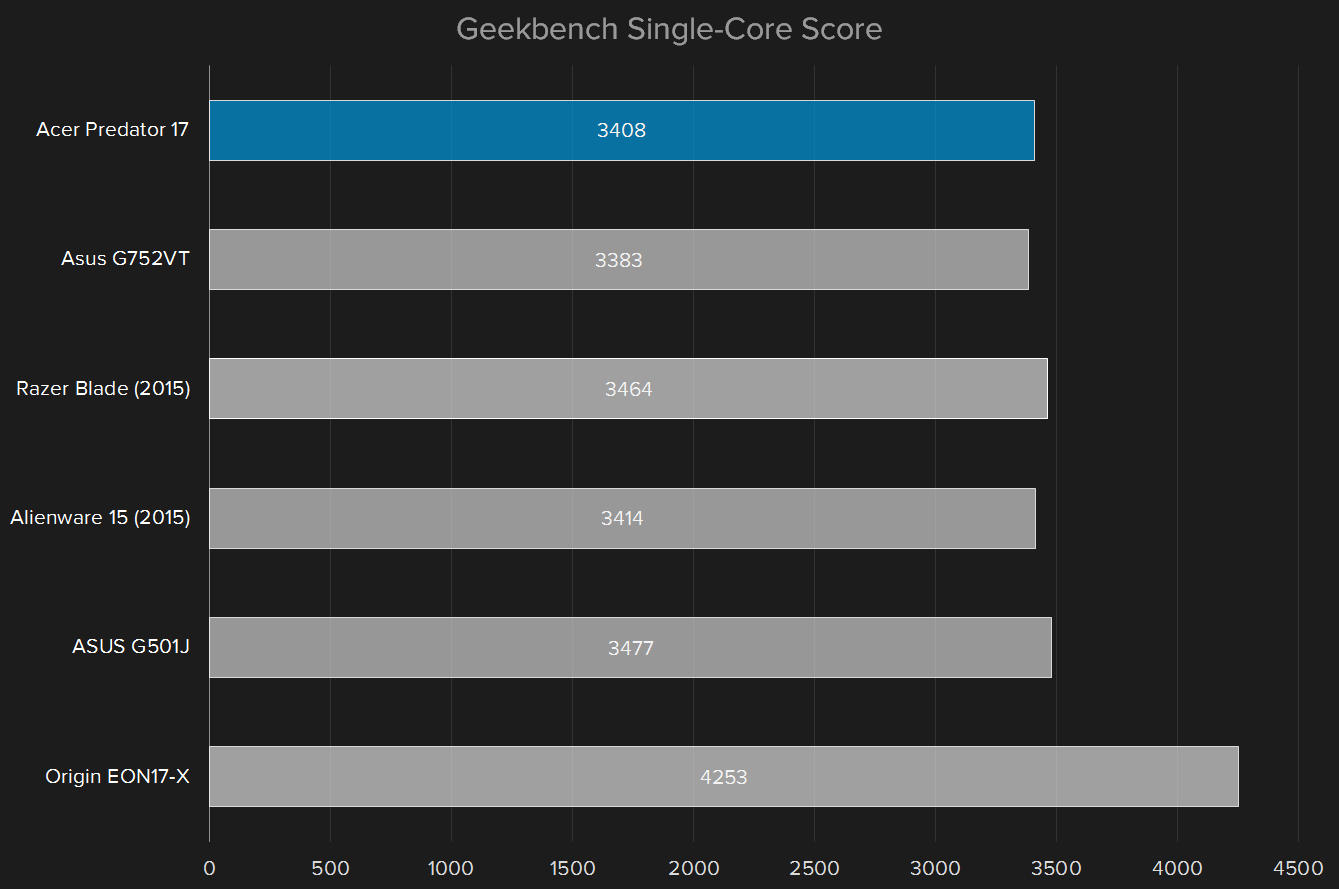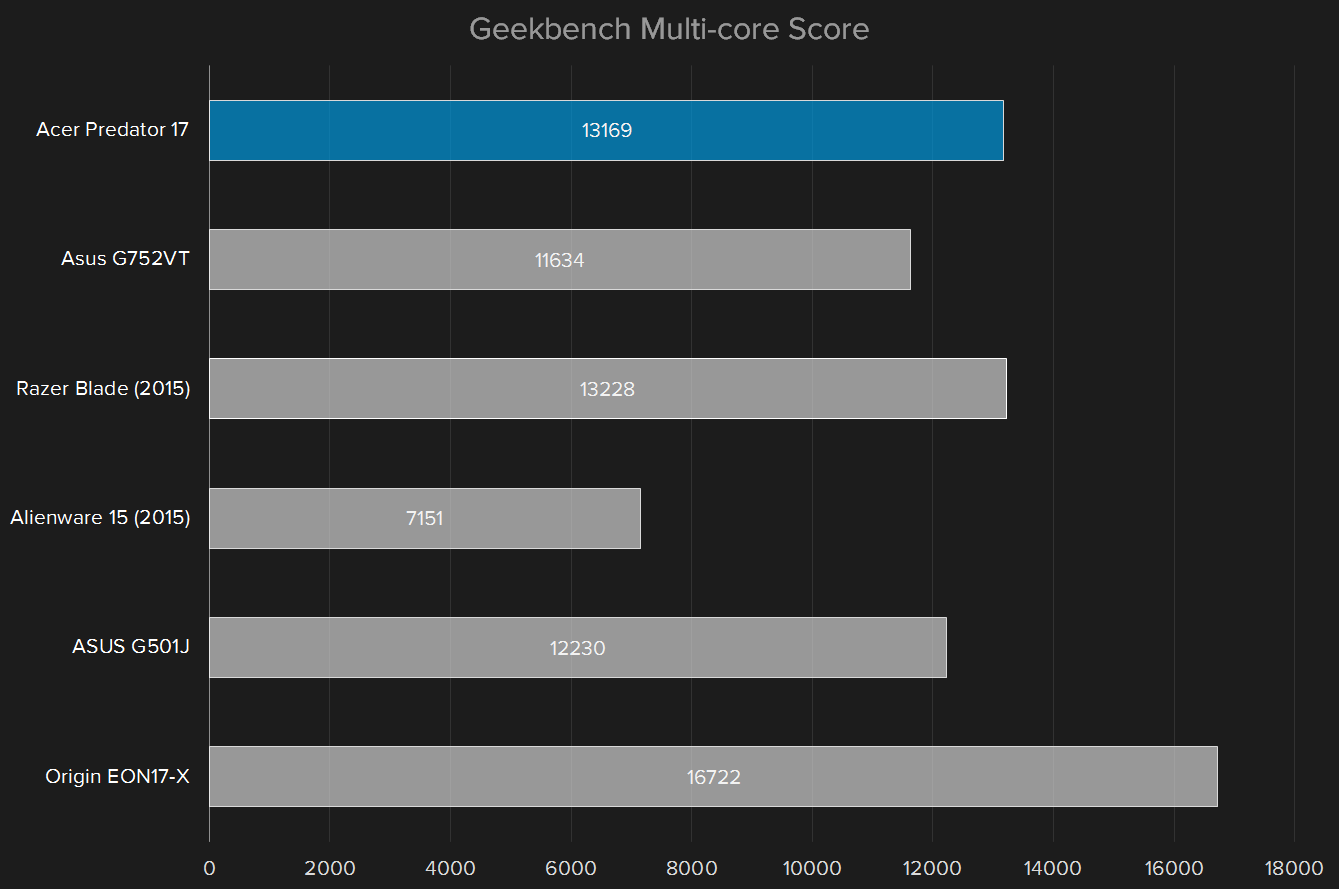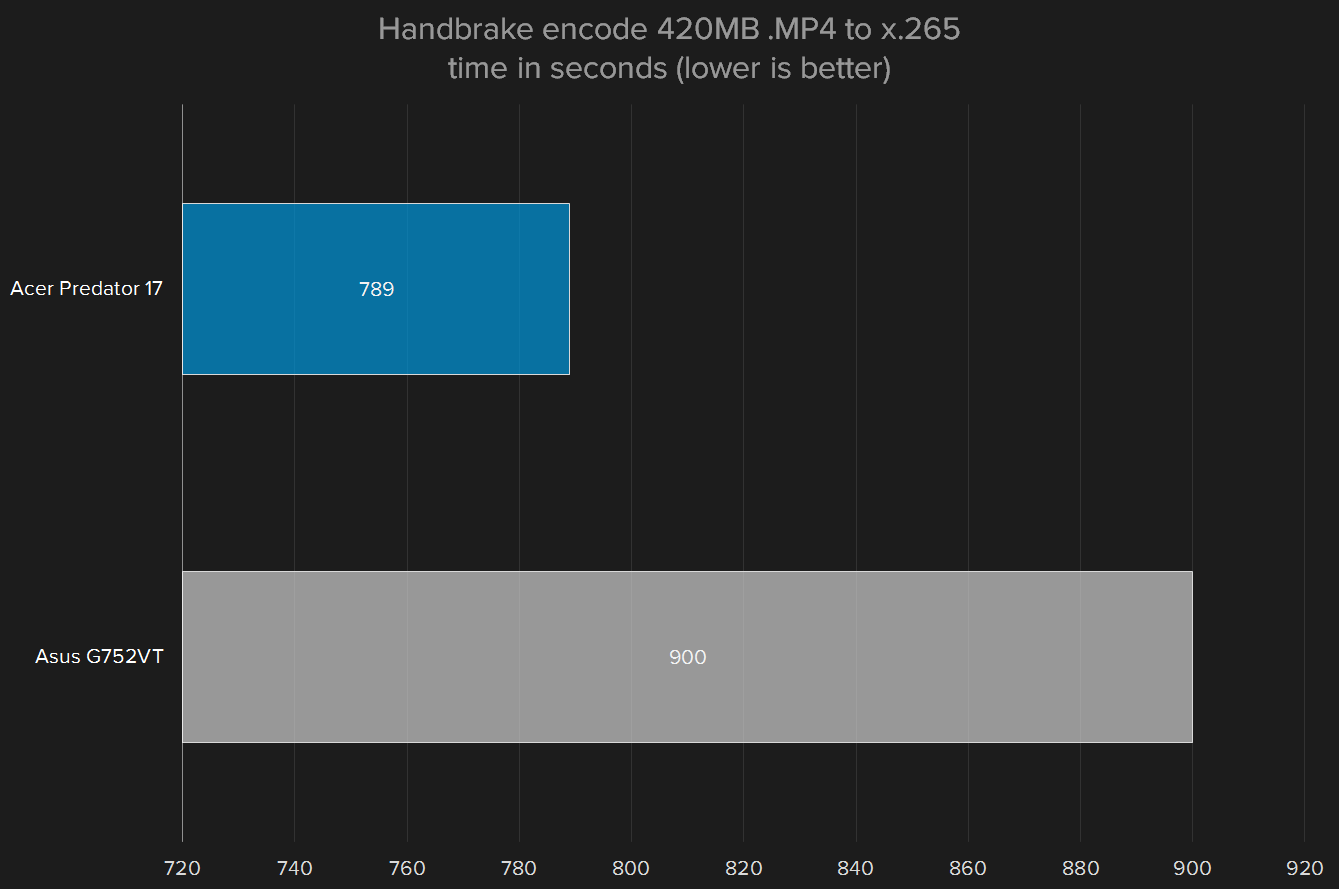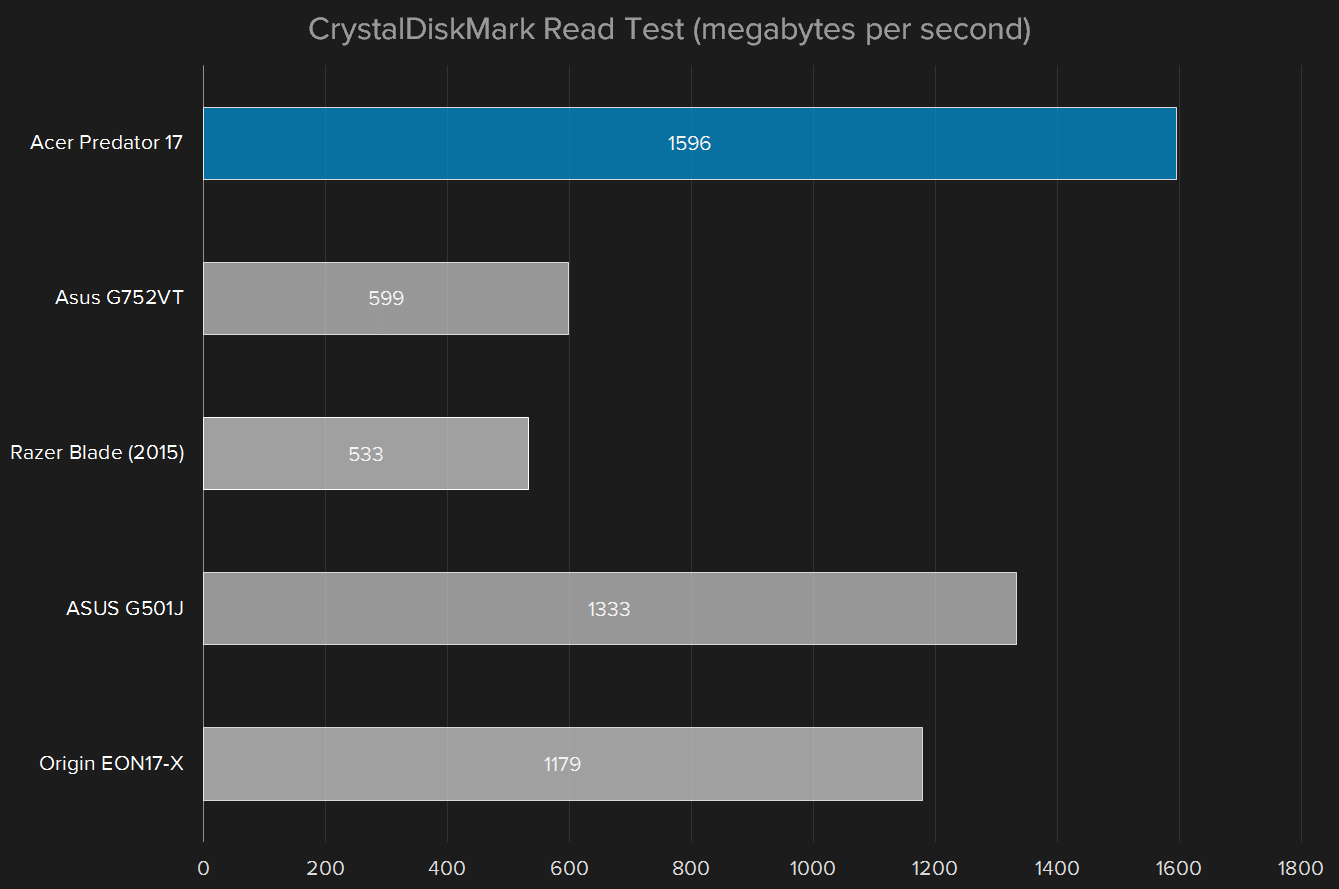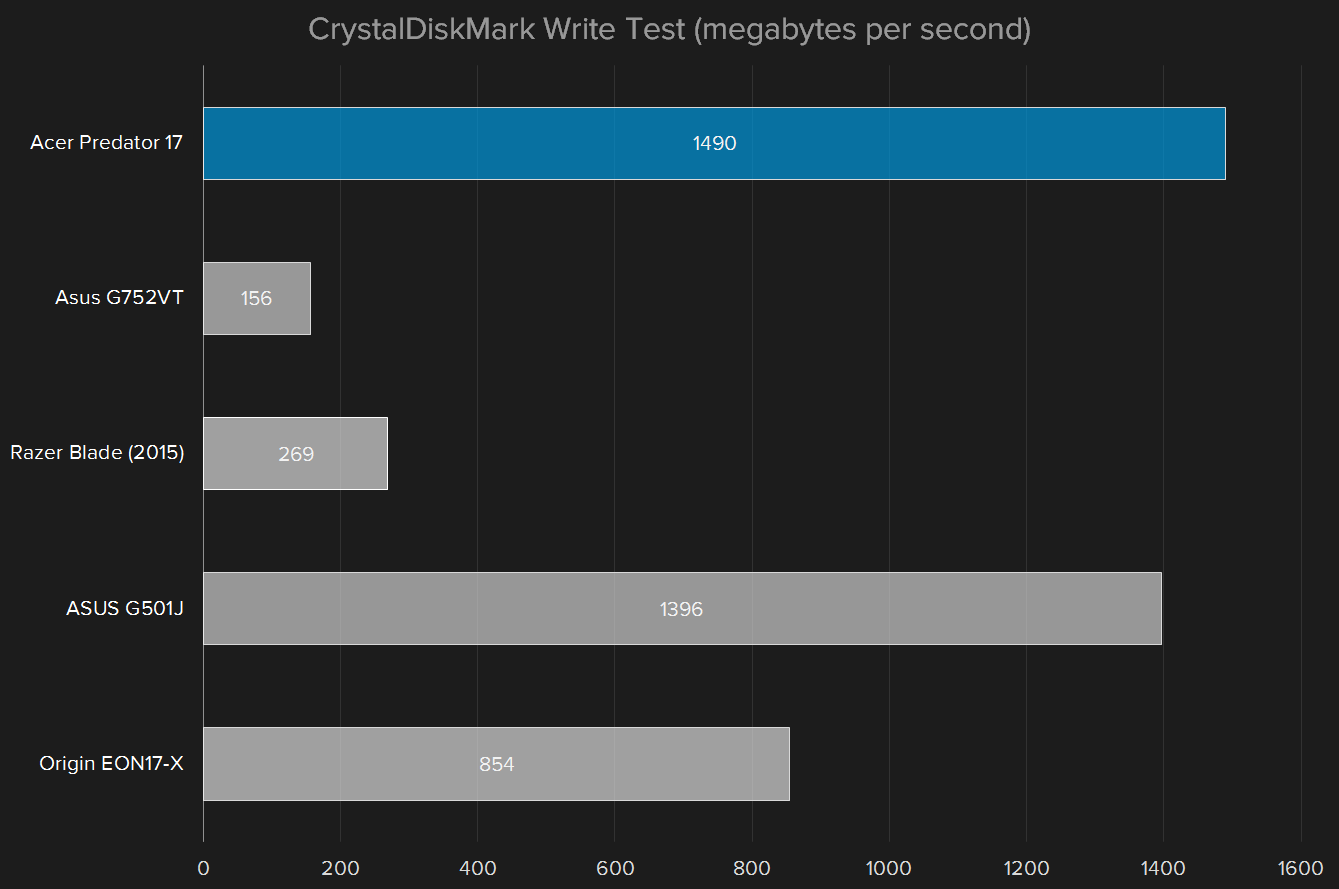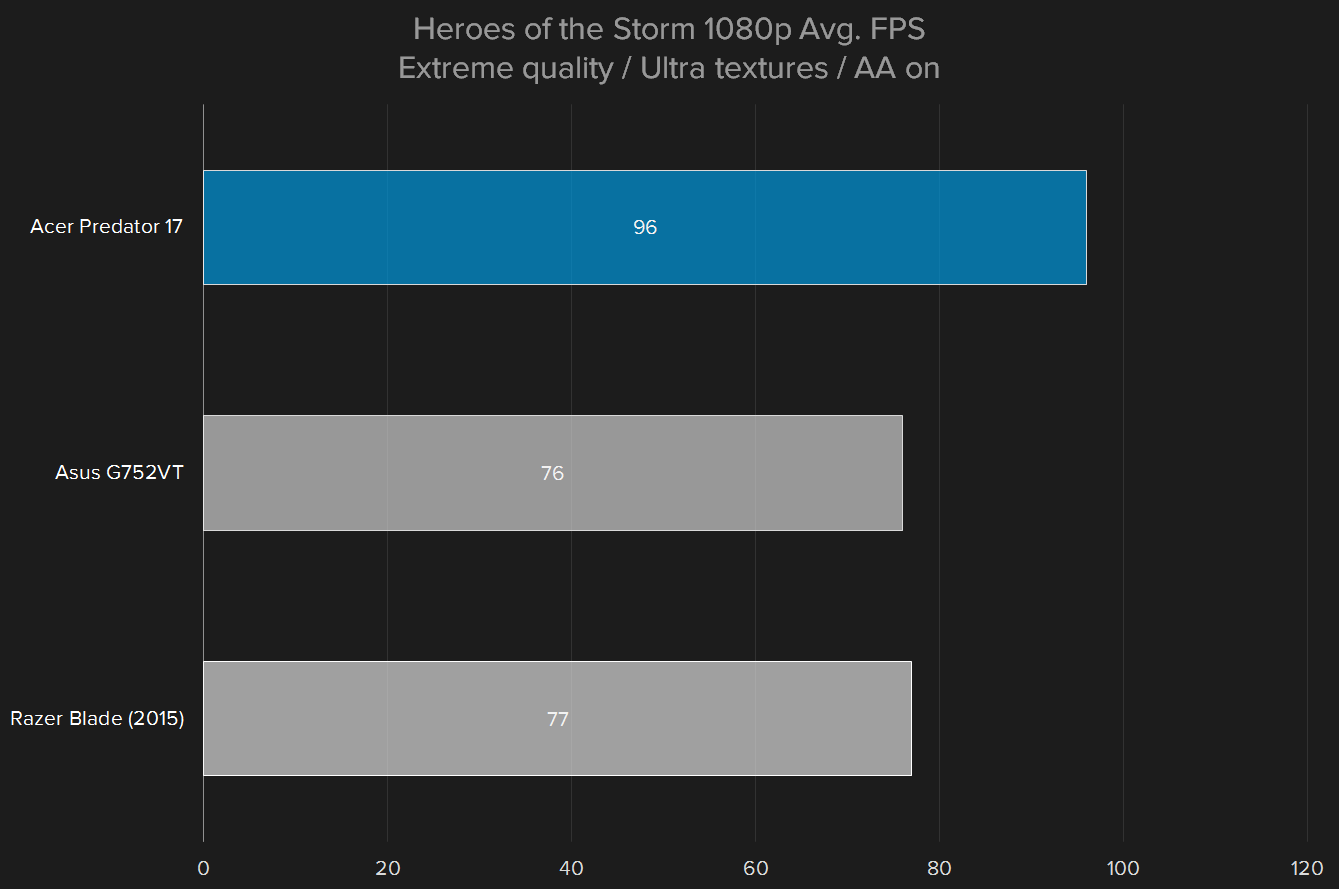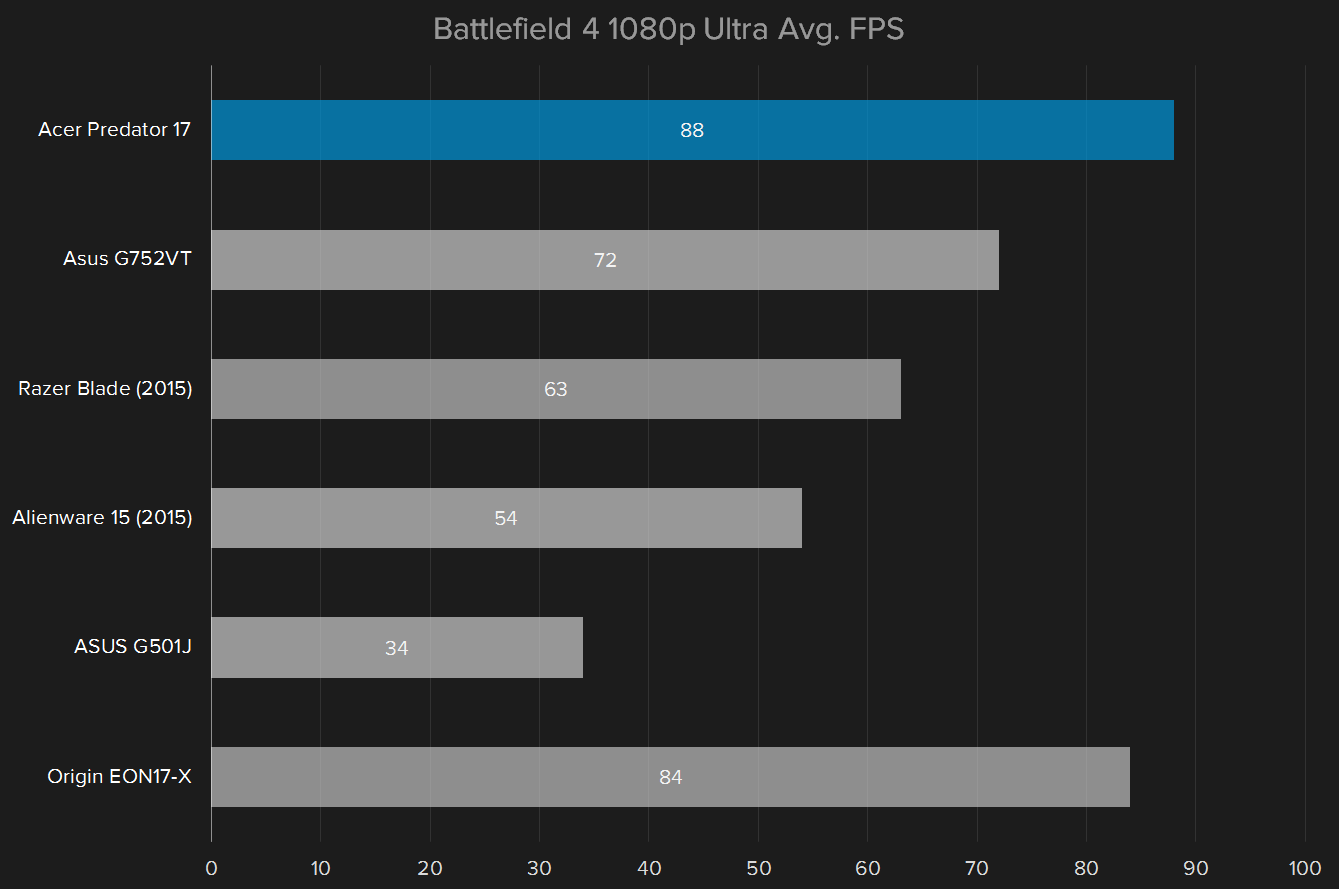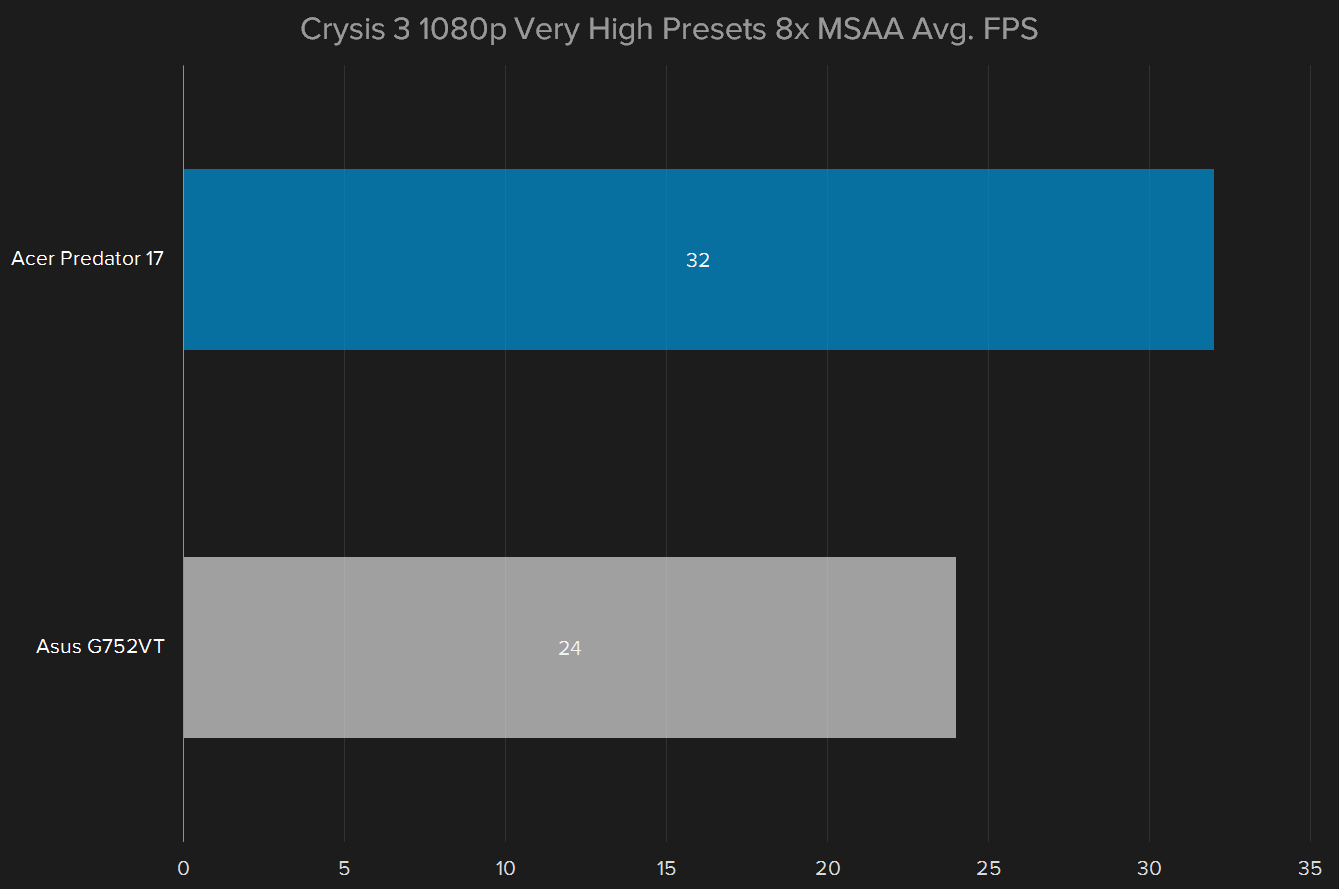- Solid build quality
- Pleasant keyboard and touchpad
- Loud, bass-heavy sound system
- Excellent performance in all areas
- Surprisingly long battery life
- Bundled gaming mouse
- Derivative design
- Mediocre display
Acer has long had a presence in PC gaming, not only through its Predator sub-brand but also through a variety of systems that, while not explicitly design for games, offer strong hardware for the price. The best current example of this is Acer’s Aspire V15 Nitro Black Edition, which packs a GTX 950M for as little as $850, or a GTX 960M for $950.
Yet the brand’s appeal often diminishes as prices rise. Unlike Asus’ Republic of Gamers, Acer’s Predator line has struggled to root itself in the minds of hardcore gamers. Buyers turn to the company for value, but often go elsewhere for high-end hardware.
IFA 2015 signaled a change. Acer stormed the show with new laptops, desktops and monitors targeted at the most hardcore gamers. Its efforts impressed Digital Trends, earning the company a Best of IFA 2015 Computing award for its debut of the Predator 15 and 17.
Now the Predator 17 has arrived in our lab for review. Its impressive list of equipment includes an Intel Core i7-6700HQ, 32GB of RAM, Nvidia GTX 980M graphics chip, and two hard drives, one a 512GB PCIe solid state unit, the other a 1TB mechanical drive with solid-state cache.
It’s a powerful configuration, and one that doesn’t try to excuse potential flaws by undercutting competitors. Our review unit carries an MSRP of $2,600, and retailer discounts don’t exceed more than a hundred bucks. Is this new Predator good enough to hunt big game?
Conventionally awesome
Acer plays it safe with the Predator’s design. Its matte black exterior is boxy, utilitarian, and accented by the cliché red lighting that’s so common in the gaming market. This system could easily be solid by Asus, MSI, or Origin with a simple swap of logos. Don’t mistake this to mean the system looks bad. It’s handsome – but also a bit bland.
What the rig lacks in originality, it makes up for in quality. Though clad entirely in plastic, the beefy Predator 17 feels thoroughly solid. Panel flex is minimal even when the system is held by a corner, an impressive feat for any large gaming notebook, and more so for a system with an optical drive bay. The display twists if purposely forced, but doesn’t cause distortion of the screen.
The system also benefits from a refreshing familiarity. Everything’s where it should be. The power button is beefy and obvious, the macro keys are similarly distinct, and the LED indicators for power, battery charging, and hard-drive activity are difficult to miss.
Connectivity is solid, even for a large gaming notebook. The system packs a respectable four USB 3.0 ports, plus one USB 3.1, which also supports Thunderbolt. Video connectivity includes DisplayPort and HDMI. Audio is a bit weak, as the system only provides microphone and headphone jacks, rather than an extra combo jack, or some form of SPDIF. Ethernet is joined by 802.11ac Wi-Fi, and Bluetooth 4.0 comes standard.
The keys for work or play
Like most large laptops, the Acer Predator 17 has plenty of room for a large keyboard, and puts that space to good use. A full-sized numpad is included, as are six macro keys arranged in a column on the left-hand side of the laptop.
Key feel is a highlight. There’s plenty of travel, and the spacious layout makes for a relaxed typing experience. While designed for gaming, the Predator is also great for productivity. Touch typists will breeze along at over a hundred words per minute, and all the keys provided are properly sized.
Unlike the Asus G752, the Acer Predator 17 makes a good argument for Skylake mobile quads.
Gamers will appreciate the backlighting. Although it’s not customizable, as with some competitors, it makes an effort to visually highlight important parts of the keyboard. The keyboard glows red, with special highlights surrounding the WASD and arrow keys, while the numpad is blue. It’s easy to identify important keys in the heat of a match. There’s no backlight brightness adjustment available, however – it’s on, or off.
The six macro keys, also backlit, give players a chance to customize games with additional key bindings. They’re a nice addition that puts what might otherwise be blank space to use, but users with small hands may find them too far away for easy access.
A large, responsive touchpad helps the keyboard in stealthy pursuit of productivity. It’s accurate, and handles multi-touch gestures with ease. A pair of separate, click-y left/right buttons further enhance the experience.
Gaming on a touchpad is far from ideal, however. The Predator solves that problem with a dedicated touchpad defeat button and a free, bundled mouse from Steelseries, which is identical to its $60 Rival 300. We found the mouse comfortable, and its adjustable laser sensor was precise.
Good display, great sound
All versions of the Acer Predator 17 currently come with a semi-gloss 1,920 x 1,080 display. While 1080p might seem meager next to 4K panels found on some notebooks, it’s still the best choice for mobile gaming. Resolutions beyond 1080p put too much strain on the hardware, forcing users to reduce detail in the pursuit of an acceptable framerate.
The panel achieved modest scores in our objective testing. Contrast worked out to 570:1 at the panel’s maximum brightness of 334 lux, and the color gamut came in at 92 percent of sRGB and 71 percent of AdobeRGB. The gamma curve was a perfect 2.2, which is rare for a notebook in any category. Overall, the Predator 17 is no slouch, but it does come behind the Asus G752 by a hair, which hit a contrast ratio of 650:1 while maintaining similar scores in other areas.
Still, the Predator’s display is good enough to impress. Games look vibrant and are rendered with a sense of depth. Black levels aren’t as deep as is ideal, and dark scenes can look murky as a result, but detail is usually maintained. The semi-gloss coat is very effective at reducing glare, so in-game cinematics are never interrupted by a mirror reflection of your own mug.
The system’s sound exceeds even the high bar set by the screen. The unfortunately named SoundPound system features four speakers and two subwoofers, which together pump out outrageous volume. There’s so much power, it’ll rarely need to be cranked beyond 70 percent of its potential.
Distortion does start to creep in at maximum, but quality is otherwise clear and crisp, with the twin subwoofers offering umph to bass-heavy tracks and movies. Surprisingly, there’s no hint of chassis rattle despite the system’s sweet vibes. Most owners will hear no reason to augment the built-in speakers.
CPU performance
The Acer Predator 17 arrived with a Core i7-6700HQ processor, the second Skylake mobile quad-core to arrive in our test lab, after the Asus G752. The chip has a base clock of 2.6GHz and a maximum Turbo boost of 3.5GHz.
Unlike the Asus G752, the Acer Predator 17 makes a good argument for the new Skylake mobile chip. It comes ahead of most systems we’ve recently reviewed in the Geekbench multi-core test, and also easily defeated its Asus’ competitor in 7-Zip and Handbrake. While the Core i7-6700HQ doesn’t blast the previous generation out of the water, it’s quick enough to satisfy gamers, or anyone looking for a powerful desktop replacement.
Hard drive performance
Not one, but two hard drives lurk inside the Acer Predator 17, and they’re both impressive. A 512GB Samsung 950 Pro provides the primary system storage. It’s backed up by a 1TB mechanical drive with 32GB solid state cache. That provides an excellent combination of capacity and storage, as the Samsung drive proved blazing fast.
The Predator’s solid state drive pushes nearly 1.6 gigabytes per second in reads, the highest we’ve ever seen from any drive, including those installed in desktop computers. The write speed isn’t a record-holder, but it also is among the best we’ve seen. HD Tune did not speak quite as favorably, but still recorded sustained read speeds of 1,026 megabytes per second, the best we’ve seen from a laptop and in league with most PCIe and NVMe desktop solid state drives.
We also tested the mechanical drive, though it was not included in the graph above. Predictably, it was much slower, with sustained read and write speeds peeking just over 100MB/s. That’s average for a mechanical disk.
Gaming performance
This one’s for all the marbles. While the Predator 17 is an extremely quick laptop in both processor and storage benchmarks, gaming performance matters more than anything else. Fortunately, it equips Nvidia’s GTX 980M, and that translates to impressive 3DMark results.

There’s no mystery here. The Predator 17 screams out of the gate, nearly matching the Origin EON17-X, a laptop with a GTX 980M and a desktop-class Intel processor. Asus’ G752 falls behind, but to be fair, we reviewed a less expensive configuration with a GTX 970M. We expect the 980M model would offer similar performance to the Predator.
Benchmarking games at 1080p lead to similar results.
The Predator’s GTX 980M led it to victory in every benchmark. Battlefield 4 easily exceed 60 frames per second at ultra (which means Star Wars Battlefront will perform similarly). Surprisingly, Crysis 3 achieved just over 30 frames per second with every detail cranked to maximum.
Heavy, but packing a big battery
Like most 17-inch systems, this Predator is a real beast. It’s 1.6 inches thick and weighs 8.7 pounds. That’s not unusual for a gaming notebook, and on par with the Asus G752, which is actually heavier at 9.6 pounds. This is not a laptop that you can carry easily, and in fact it won’t fit in most backpacks or bags.
Acer’s excellent standard warranty puts most competitors to shame.
Some of that weight goes to the battery, a massive 90 watt-hour unit. It has its work cut out for it powering the quad-core processor and Nvidia graphics chip, but ultimately leads the system to respectable battery-life scores. The Predator lasted five hours and 59 minutes in the Peacekeeper Web browsing loop, and 6 hours 50 minutes in an automated Web browsing macro.
That’s excellent for a gaming laptop. The Asus G752 managed a disappointing one hour and 48 minutes in Peacekeeper, and the Origin EON17-X lasted two hours, sixteen minutes. The Predator’s run time is competitive with mid-range ultrabooks.
FrostCore does less than you’d think
One of the Predator’s more unusual features it FrostCore, a standard accessory built by Cooler Master. It replaces the optical drive, easily removed with the flick of a button on the laptop’s bottom, with an additional cooling fan.
The fan had some impact on cooling performance. At idle, the system warmed to 82 degrees Fahrenheit without the fan, and a nearly room-temperature 77 degrees with. Temperature at full load also decreased from 96.8 degrees to 92.9 degrees. Fan noise did not change with or without the fan at idle, hovering around 38 decibels but noise went up at full load, rising from a modest 43dB to a rowdy 47dB.
Obviously, the fan does its job, but I’m not sure it works well enough to bother installing it. Even without, the system’s idle temperature and noise figures are commendable. The Asus G752 is a bit warmer at idle, but a few degrees cooler at load. The Origin EON17-X was warmer in every situation. Even the Dell Inspiron 15 7000, an entry-level gaming notebook, produces more noise.
Warranty
The Acer Predator 17 is covered by a two-year warranty, rather than the one year of coverage found on most competitors. Owners also have access to a dedicated Predator support line, separate from the line for customers of other Acer products. These advantages give Acer a definite edge over other big-name manufacturers in the laptop world. Only smaller companies, like Falcon Northwest and Origin, can boast better service.
Conclusion
The new Predator 17 was the most promising new laptop to debut at IFA 2015, and it lives up to that promise. While it’s not the most exciting notebook at first glance, its conventional design, combined with excellent hardware, makes for an incredible all-around system. It robs the Asus G751 of its championship title and, like that rig, has appeal that extends beyond gaming. The Predator’s fast processor, pleasing keyboard, and large battery make it a solid workstation, as well.
The DT Accessory Pack
Up your game and the get the most out of your gear with the following extras, hand-picked by our editors:
Targus Drift II backpack ($57.78)
A laptop as large as the Predator 17 won’t fit in just any backpack. You’ll need a massive one, like this Targus Drift.
BenQ RL2755HM Gaming Monitor ($220.69)
The Predator’s display is big, but it’s no monitor. BenQ’s affordable 27-inch monitor can expand your gaming experience.
Logitech G230 Stereo Gaming Headset ($64)
This Logitech gaming headset offers stereo sound and a clear microphone to keep you in touch with other gamers.
Acer is aware it has a winner on its hands, and has priced the notebook accordingly. Our review unit’s $2,600 MSRP is sure to make some buyers balk. Acer does offer a more affordable base model, priced at $1,600, with a GTX 970M and much smaller 128GB solid state drive, along with a downgrade from 32GB to 16GB of RAM. The best overall value is likely the G9-791-78CE configuration, which cuts the RAM and SSD capacity of our review unit in half, but keeps the Core i7-6700HQ and GTX 980M. That configuration retails for $2,000.
The Predator is competitive with the market in any configuration. An Asus G752 with similar hardware, and a smaller SSD, will set you back $2,700. Alienware’s 17 is $2,850, though at time of this writing it’s a bit of a steal thanks to a $500 holiday discount, which drops it to $2,350. All three systems are similarly equipped in their base incarnation, and range from $1,400 to $1,600.
But enough with the comparisons. The verdict is simple. If you want a serious gaming notebook, you should buy the Acer Predator 17. It’s the best we’ve ever reviewed.
Highs
- Solid build quality
- Pleasant keyboard and touchpad
- Loud, bass-heavy sound system
- Excellent performance in all areas
- Surprisingly long battery life
- Bundled gaming mouse
Lows
- Derivative design
- Mediocre display







